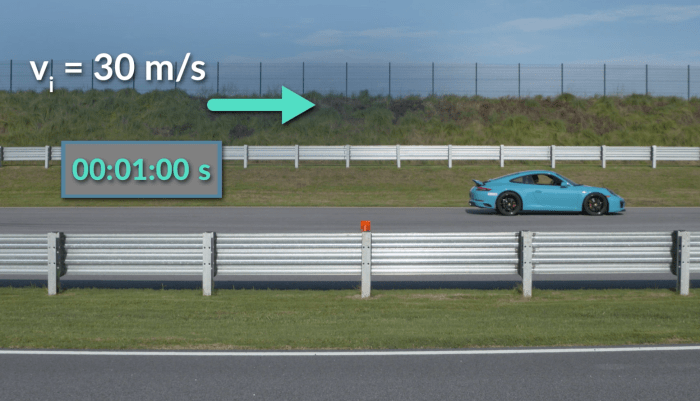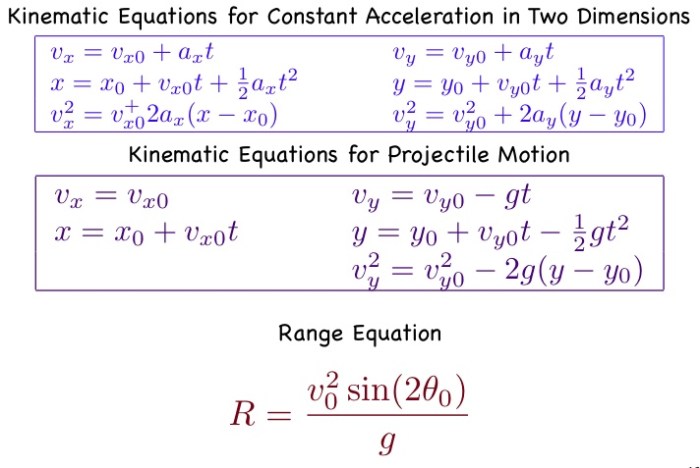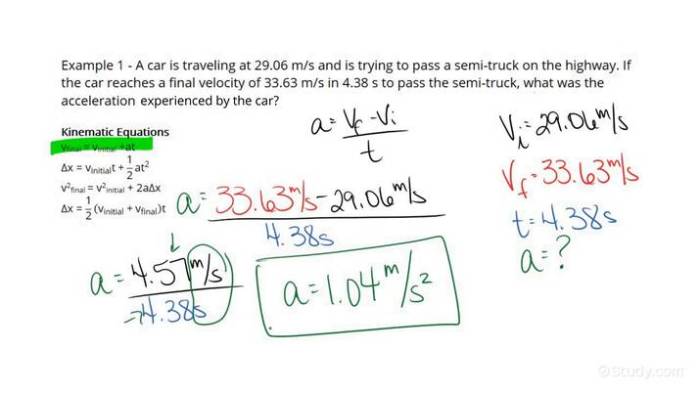Welcome to the realm of unit 2c acceleration and kinematic equations practice problems answers, where the intricacies of motion unravel before your very eyes. This comprehensive guide delves into the fundamental concepts of acceleration and kinematics, empowering you to conquer practice problems with precision and finesse.
As we embark on this journey, we will explore the diverse types of acceleration and kinematic problems, mastering the key concepts and formulas that govern each. Through step-by-step solutions, you will gain a profound understanding of how to approach and solve these problems effectively.
1. Acceleration and Kinematic Equations Practice Problems: Unit 2c Acceleration And Kinematic Equations Practice Problems Answers

Acceleration and kinematic equations are mathematical formulas used to describe the motion of objects. These equations relate the position, velocity, and acceleration of an object to each other. Practice problems involving acceleration and kinematics help students understand the concepts and apply them to real-world situations.
Common types of acceleration and kinematic practice problems include:
- Constant acceleration problems: In these problems, the acceleration of the object is constant, and the equations of motion can be used to find the object’s position, velocity, and acceleration at any time.
- Projectile motion problems: These problems involve objects that are launched into the air, and the equations of motion can be used to find the object’s trajectory, range, and maximum height.
- Circular motion problems: These problems involve objects that are moving in a circle, and the equations of motion can be used to find the object’s centripetal acceleration, tangential velocity, and period.
2. Common Types of Acceleration and Kinematic Problems
| Problem Type | Key Concepts | Formulas |
|---|---|---|
| Constant Acceleration | Velocity and acceleration are constant | v = u + ats = ut + 1/2 at2v2 = u2 + 2as |
| Projectile Motion | Acceleration due to gravity is constant | v = u + gts = ut + 1/2 gt2v2 = u2 + 2gs |
| Circular Motion | Centripetal acceleration is directed towards the center of the circle | a = v2/rv = 2πr/TT = 2πr/v |
3. Applications of Acceleration and Kinematic Equations

Acceleration and kinematic equations have numerous applications in various fields, including:
- Physics: These equations are used to analyze the motion of objects in a variety of situations, such as projectile motion, circular motion, and free fall.
- Engineering: These equations are used to design and analyze the performance of machines, such as cars, airplanes, and rockets.
- Sports: These equations are used to analyze the motion of athletes, such as runners, jumpers, and throwers.
4. Advanced Topics in Acceleration and Kinematics

| Topic | Key Features | Applications |
|---|---|---|
| Relative Motion | Describes the motion of objects relative to each other | Analyzing the motion of cars, airplanes, and other moving objects |
| Non-uniform Acceleration | Acceleration is not constant | Describing the motion of objects that are accelerating or decelerating at a varying rate |
| Vector Analysis | Describes the motion of objects using vectors | Analyzing the motion of objects in three dimensions |
5. Resources for Further Learning

To learn more about acceleration and kinematics, you can refer to the following resources:
- Books: “University Physics” by Young and Freedman, “Physics for Scientists and Engineers” by Serway and Jewett
- Websites: Khan Academy, The Physics Classroom, Brilliant
- Online courses: Coursera, edX, MIT OpenCourseWare
FAQ Resource
What is acceleration?
Acceleration is the rate at which an object’s velocity changes over time.
What is kinematics?
Kinematics is the study of motion without regard to the forces causing it.
How do I solve practice problems involving acceleration and kinematics?
Follow the step-by-step methods Artikeld in this guide, carefully applying the relevant concepts and formulas.